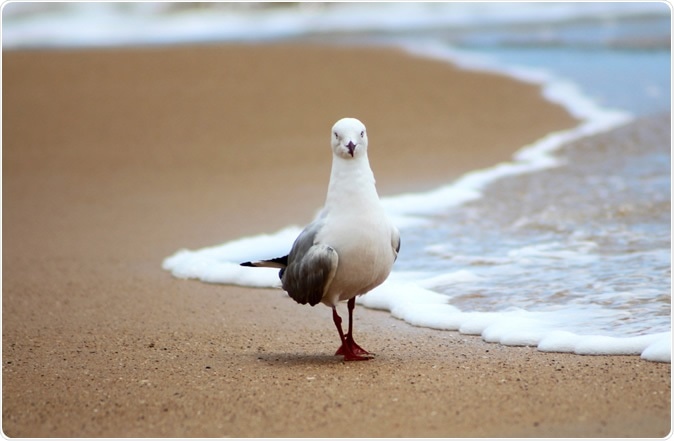They say it's good luck for a seagull to poo on you. Now, in a surprising observation, a team of Australian scientists found that one in five silver gulls in Australia harbored antibiotic-resistant bacteria, which could cause a wave of serious human infections. This comes against a background of increasing alarm over the emergence of antibiotic resistance in many common bacterial species.
These findings come from a study by researchers at Perth’s Murdoch University, who were looking at antimicrobial resistance in humans and animals. The report was published on July 10, 2019, in the Journal of Antimicrobial Chemotherapy.

A Silver Gull (Chroicocephalus novaehollandiae). Image Credit: Kate Haskova / Shutterstock
Seagulls are migratory birds, traveling long distances of up to 1,600 kilometers from their nests. They feed on leftovers discarded by humans as well as on animal and human waste, and sewage. They become infected with bacteria of the species Escherichia coli (E. coli) by contact with human feces. This contact is probably occurring through used diapers at garbage dumps, or through sewage.
To prove this was happening, 562 samples were taken from the birds from different places around Australia and tested for different bacteria. The species selected for the study was the silver gull, the most common type in Australia, because the scientists suspected that drug resistance could be partly due to animal-human interaction, especially when the animals are commonly found in human environments.
The scientists were shocked to find high levels of antibiotic-resistant E. coli in the seagull samples. Researcher Mark O’Dea said, “Seagulls could be acquiring this pathogen through their opportunistic feeding habits where they scavenge from leftover human waste and may then be subsequently spreading these resistant bacteria over vast distances.”
Moreover, many of these bacteria were actually clones of those found in humans in health care facilities. This confirmed that they had not been transferred from seagull to seagull, but through contact with human waste.
O’Dea said there was a negligible risk of passing on the infection to human beings, but admitted it could still happen. In most healthy people, the bacteria would not cause infection even following their ingestion. However, people with weakened immune systems, for instance, would be at risk. Moreover, as the gulls fly around the country, they will be able to disseminate the antibiotic-resistant infection over long distances. In addition, gulls make use of the same environment as humans, thus increasing the chances of spreading these superbugs to humans. For instance, at beaches or in parks, fresh seagull droppings could be touched by people.
E. coli typically causes human urinary tract infections, sepsis and in a few patients, meningitis. However, some of the bacteria found in the seagulls were not susceptible to cephalosporin or fluoroquinolone, two commonly used antibiotics. Even more serious, one bacterial sample failed to show growth inhibition even when exposed to carbapenem, which is among the last-reserve drugs, used only to treat severe infections or those which put the patient at high risk.
Lead researcher Dr Sam Abraham described this as a wake-up call to all government and other agencies to manage waste properly.
The World Health Organization has already issued warnings that superbugs are on the rise, and has brought attention to the urgent need to bring out new antibiotics capable of dealing with these. It said: “Antimicrobial resistance (AMR)-- the ability of bacteria, parasites, viruses and fungi to resist these medicines -- threatens to send us back to a time when we were unable to easily treat infections such as pneumonia, tuberculosis, gonorrhea, and salmonellosis. The inability to prevent infections could seriously compromise surgery and procedures such as chemotherapy.”
The European Centre for Disease Prevention and Control reported that there were 33 000 deaths in 2015 directly linked to infection with antibiotic-resistant bacteria. In fact, the rise in antimicrobial resistance is widely regarded by medical experts as among the biggest dangers looming ahead for human health.
The Australian study is not isolated in its findings, nor is it the earliest warning of its kind. In 2017, a French study found the same superbug to be carried in yellow-legged gulls in southern France. The authors called it “alarming”, and called urgent tracing of the source of contamination. A German study has also shown the presence of antimicrobial-resistant Salmonella in wild birds.
The WHO has identified factors responsible for the spread of antibiotic resistance, including poor sanitary standards for food handling, lack of hygiene in the environment, low sanitary conditions and lack of adequate infection control measures. The Australian scientists recommend that people take the simple precaution of washing their hands or using a hand sanitizer after coming in contact with gull droppings, to minimize the chances of infection.
Journal reference:
Shewli Mukerji, Marc Stegger, Alec Vincent Truswell, Tanya Laird, David Jordan, Rebecca Jane Abraham, Ali Harb, Mary Barton, Mark O’Dea, Sam Abraham, 'Resistance to critically important antimicrobials in Australian silver gulls (Chroicocephalus novaehollandiae) and evidence of anthropogenic origins', Journal of Antimicrobial Chemotherapy, , dkz242, https://doi.org/10.1093/jac/dkz242